For those living in Spain, you will know the Spanish love a good party. Therefore, it is no surprise that there ARE plenty of fiestas, ferias, festivals, and celebrations. So, if you are planning a trip to Spain or want to visit a different part of the country during 2023, InSpain.news has put together a selection of just some of the events you might want to add to your diary.
The list of ferias, fiestas, celebrations and holidays in Spain is endless. However, we hope you enjoy the ones we have chosen.
JANUARY
Three Kings Parade – January 5

The three Kings Parade or “Cabalgata de Los Reyes Magos” in Spanish and “Cavalcade del Reis Mags” in Catalan, is held on the evening of the 5th of January each year. Every town and city has a Three Kings procession where participants throw sweets to the children from the floats. Moreover, it is a wonderful family evening out.
Also read: Festive sweets and treats
You can buy a Roscón from any bread or cake shop, or even in the supermarket.
Some children may leave a clean pair of shoes by the door with a note inside and some straws. And at night, when the children go to bed, the three kings with their camels visit. Then they leave gifts to be received in the morning.
Three Kings Day – January 6
At the end of the Twelve Days of Christmas comes a day called the Epiphany, or Three Kings Day. This holiday is celebrated as the day the three wise men first saw baby Jesus and brought him gifts.
In many Spanish families, this is the main gift-giving holiday. Furthermore, it is also the day of the lottery El Niño, with a first price of €2 million. The Loteria del Niño gets its name from baby Jesus. Niño in Spanish means ‘the little one,’ and is held on the day of the Three Kings day.
Tamborrada – January 20
La Tamborrada of Donostia is a celebratory (and loud) drum festival which is held each year from midnight on January 19 in the city of San Sebastián. Rain, hail or shine, thousands pack Constitution Square when the mayor raises the San Sebastián flag at midnight to signal the 24 hours of non-stop drumming to begin. Around 150 Tamborradas are featured on the streets throughout San Sebastián. Then at midnight on January 20, the flag is lowered, and the drums stay silent. That is of course, until next year!
Jarramplas – January 20
The Jarramplas festival is celebrated on the same day as that of La Tamborrada in San Sebastián. As with most traditions, the origins sometimes are a little unclear. In the case of Jarramplas in Piornal, Extremadura, there are 3 possible beginnings.
The Jarramplas could be the Christian warrior despised by people during Morish domination. Alternatively, it is believed he was a martyr killed by the Jewish for not renouncing Christianity. But finally, the most popular of the legends is the story of a man (or a werewolf) who was a cattle thief. Eventually, he was caught and punished after having repeatedly stolen and killed cattle in the neighbourhood.
Jarramplas – Turnip throwing

Each year, it is a great honour for a male from the village to be chosen to represent the Jarramplas. The Jarramplas dresses like the devil in a costume with multicoloured ribbons, a horse´s mane and horns. At the stroke of midnight on the 19th, the Jarramplas sounds out 12 beats of his drum. The villagers bombard him by throwing turnips as the chase begins. He then runs around the village beating his drum as the villagers continue to throw turnips at him.
The festival goes on until the Jarramplas can´t take any more. At this point, he removes his mask, and the turnip throwing stops. However, the pride is in how long the “Jarramplas” manages to last. Then, villagers are invited to the home of the Jarramplas to eat migas as well as chorizo, cheeses, wine etc. The feast is provided by the family and friends of the Jarramplas and forms part of the feast for Saint Sebastián.
FEBRUARY
The Arizkun Carnival – February 1-3
Celebrated in Arizkun, Navarra where thousands of people line the streets ready to jump over bonfires. The locals dress up in scary-looking sheepskin costumes and black pointy-style hats, carrying brushes. This somewhat weird and colourful tradition dates to pagan times and is said to encourage fertility and ward off evil spirits.
Almond Blossom Festival – February 4-5

The Almond Blossom Festival is due to take place in Tejeda, Gran Canaria. Originally this was a pagan festival, but now thousands of people enjoy the beauty of the Almond blossoms. The weekend is filled with music and crafts, and of course, the wonderful sight of the almond blossoms everywhere. Tejeda and its famous almonds are included in the list of the most beautiful villages in Spain
The Santa Agueda festival – February 5
Many of the festivals and events in Spain are carried out by men. However, The Santa Agueda Festival is celebrated by women. Therefore, on this day, the town belongs to them. The town of Zamarramala in Segovia comes to life with the singing and dancing of the town’s women. The festival Zamarramala commemorates the battle of Segovia in which the Moors attacked and conquered the area in 1227. During the battle, the women entertained the Moors while they were battling to take over the town’s fortress.
Bodas de Isabel de Segura in Teruel – February 16-19
A truly unique experience as the city of Teruel remembers the tragedy of the “Lovers of Teruel“. Inhabitants recreate a medieval atmosphere and scenes from the story. Teruel is part of the “Europa Enamorada” (Europe in love) network of cities where love stories have taken place and left an imprint on the area.
Participants recreate different scenes in the streets of Teruel from the story of the Lovers of Teruel, who promised each other eternal love. Consequently, the city will become a festival that will take us back to the 13th century. As well as seeing events like the entrance of the Aragon troops right in the city centre, visitors can go to exhibitions and concerts, taste typical produce, attend traditional craft workshops, watch falconry displays and sword fights, and much more.
Andalucia Day – February 28
Tuesday 28 is an important day for Andalucia and many will take the day before as a holiday to give the long holiday weekend (Puente. During the celebrations of the Día de Andalucía Andalusians decorate their houses and apartments with the green and white colours of Andalucia. Furthermore, they organize many street parties and parades throughout the region. This holiday commemorates the Statute of Autonomy of Andalucia referendum held on February 28th, 1980, in which the Andalucian people voted for the statute that made Andalucia an autonomous community of Spain.
Festival de Jerez – February 24–March 11
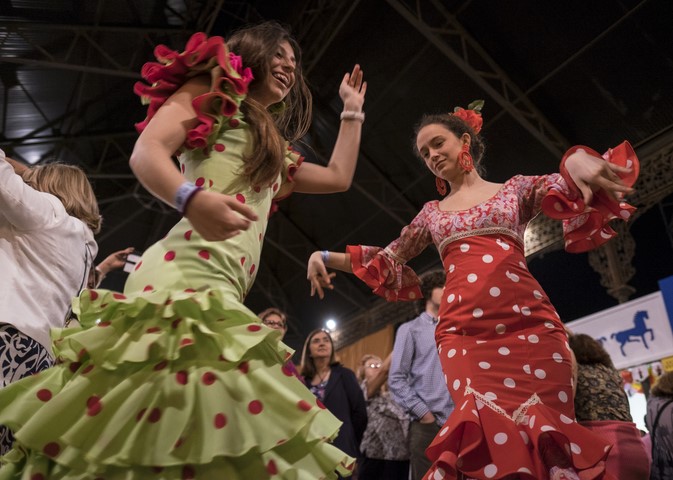
This festival is packed with entertainment every single day. Here you will find the most authentic flamenco, and with a massive programme of events, there is something to suit everyone over the 15 days. The Festival de Jerez welcomes flamenco lovers from all around. This is a place where artists and the public meet to share their love for flamenco, and it invites you not only to look but also to participate in a unique and genuine experience.
February and March are Carnival times in Spain
You can find a carnival in just about every area of Spain during February and March. Therefore, this is just a small selection.

Cadiz Carnival – February 16-23
Every year the gorgeous city of Cadiz in Spain hosts one of the funniest and most entertaining carnivals in the world! Cadiz Carnival is one of the most extravagant parties you will ever attend. There is carnival music being played in every corner of the city. Moreover, this is a fun-filled carnival where the whole city gets involved. There are street parties, colourful processions, and extravagant costumes.
Barcelona – February 16-22
The Carnival in Barcelona is the last big party before the period of suffering and willpower (lent) begins. In the UK it is celebrated by emptying the cupboards of all things delicious and making pancakes. In Spain, it is celebrated with a party – of course! The fun begins on ‘Fat Thursday’, and ends the following Wednesday with a traditional ceremony in which sardines are buried to symbolise the beginning of lent.
Madrid – February 17-22
Similar to that of Barcelona, the Madrid carnival is one big party, which ends before ash Wednesday with the burial of the sardine.
Gran Canaria – February 10 – March 5
The Las Palmas de Gran Canaria Carnival is known as one of the best free parties in Europe! For three weeks every year, they celebrate one of the biggest, and best carnivals in the world! During Carnival, every corner of this island transforms into a non-stop party, filled with music, colour, humour, dancing, feasting and fun!
MARCH
Balearic Day – March 1
Dia de les Illes Balears is a celebration and public holiday in the Balearic Islands. Every year on 1 March people celebrate it and commemorate the creation of the Balearic Statute of Autonomy within the Spanish Constitution that became effective on 1 March 1983.
Festival Cine Malaga – March 10-19
The Malaga Film Festival takes place from March 18-27 and celebrates its 26th anniversary. The festival presents Spain’s best documentaries and short films. Furthermore, it helps promote the development of Spanish language films. Consequently, it is an event for every audience.
Las Fallas de Valencia – March 14-19
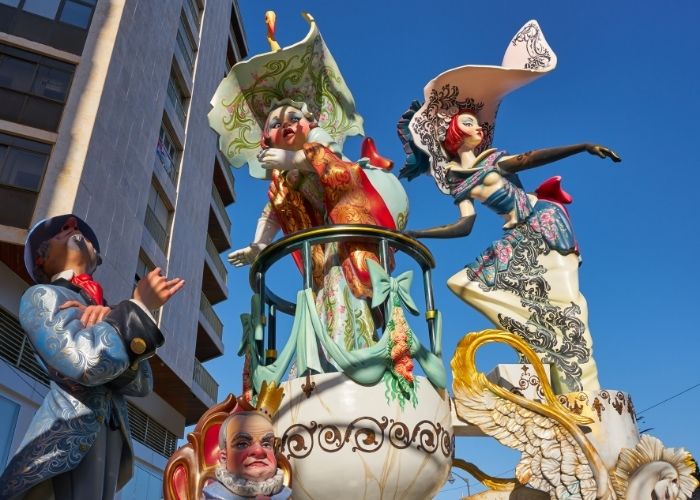
Valencia lights up its streets for an entire week of celebration and parties. The whole city gets involved in Las Fallas as inhabitants create giant paper maché figures representing famous characters. They display these in the city during the full week of the celebration before they throw the figures onto bonfires. Every year the town chooses a winner for the best creation. Sometimes it can take an entire year to create these fallas.
This year, the Palau de Les Arts will be the new home for the Fallas fireworks, including Nit del Foc. The new location is behind the City of Arts building. “This is a large space that will allow better visibility by the public and greater creative and artistic possibilities”, announced the Councilor for Festival Culture Carlos Galiana. Click here for the programme of the Fallas 2023.
San Jose Day – March 19
March 19th is “Día de San José”, the day celebrating Saint Joseph. Saint Joseph, the bible says, was engaged to Mary when she became pregnant with Jesus. They married, and raised him together, so San José day is also Father’s Day in Spain and many other Catholic countries.
Arrival of the Caravel La Pinta Festival – March 3-5
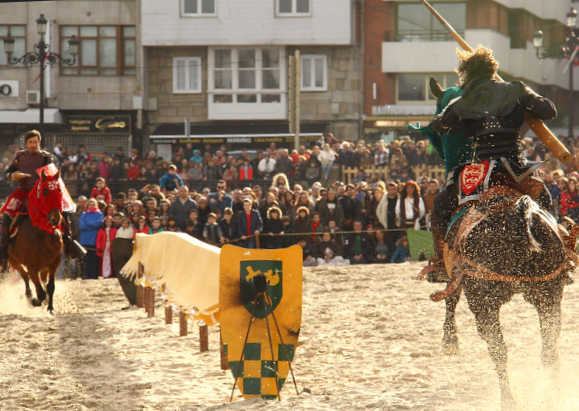
Baiona, in Pontevedra, celebrates this festival to commemorate the arrival of the caravel “La Pinta” in its port, bringing the news of the discovery of America. And, to remember this important historical event, there are many celebrations in March. A real medieval festival takes place on the streets of the old town, selling typical 15th-century crafts. Also, musicians, minstrels, jugglers and artisans provide entertainment for the visitors.
One of the most relevant moments is the performance of the story that Martín Alonso Pinzón and his crew told the mayor of Baiona about the discovery, on 1 March 1493. Then the Baiona Gold Medal is awarded. It is given to people or associations who have worked to promote culture regarding emigration. An official ceremony takes place in which the representatives from the town councils of Palos de la Frontera (Huelva), Santa Fe (Granada) and Pornic (France) – which are twinned with Baiona – take part.
Reconquest of Vigo – March 28
Every March, the historic city centre of Vigo in Pontevedra (Galicia) is transported back to the early 19th century. In this way, they commemorate the popular uprising when the citizens of Vigo expelled Napoleon’s troops from the city at the start of the Peninsular War (1808-1814).
Vigo succeeded as the first European city in reclaiming its independence from French occupation. This happened on 28 March 1809. Therefore, every year, the citizens of Vigo proudly celebrate its anniversary, known as the ‘Reconquista de Vigo. The historic city centre becomes a large outdoor market where you can buy all sorts of foods (empanadas, steaks and pancakes, with local spirits) and crafts. The streets are decorated and the locals dress in period costumes. Consequently, they bring the the18th-century soldiers, peasants and fishermen to life.
In any corner of the city, you can find French troops battling Galicians in a multitude of re-enactments. One of the most important depicts is the incident at Puerta de Gamboa, led by two of Vigo’s most beloved local heroes: Carolo and Cachamuiña. As well as the historic festival, the city comes alive with concerts, culinary tastings and other events over several days going into early April.
APRIL
Entierro de la sardina
This is quite a strange festival which normally takes place immediately after the carnivals have finished. Its true origins are not known, although, as with many traditions in Spain, there are also many theories. The actual burial of the sardine is a ceremony.
One such theory states that in the 18th century, King Carlos III received some sardines that turned out to be rotten. Therefore, he immediately ordered them to be buried. However, mainly, the ceremony is used is to mark the beginning of lent after the celebrations of the Carnivals have ended. The locals dress up in black, some as priests and some as nuns. They carry the sardines through the town for everyone to see in something like a funeral procession which ends up at a bonfire. Then, a symbolic sardine is burned. This is said to drive away evil and negative thoughts with the ashes representing happiness, peace, and harmony. When the sardines are buried, it is said to purge the past and allow society to be reborn and transformed with new energy and life.
Murcia sardine festival – April 15
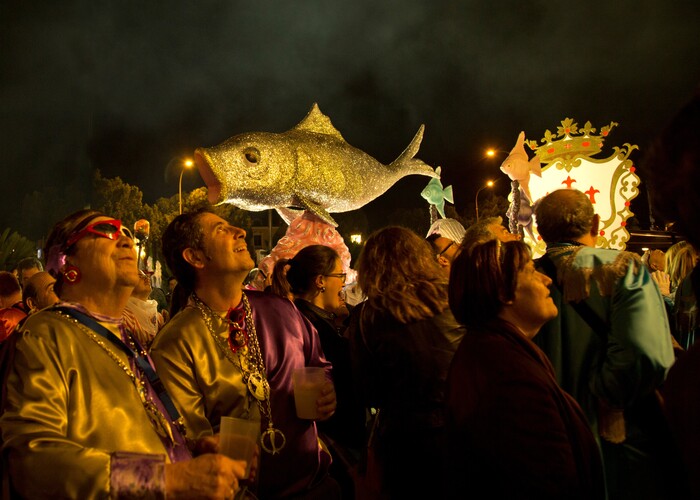
However, one of the most famous Sardine Festivals is in Murcia. This does not follow the above tradition. Instead, the Burial of the Sardine festival here is unique. This year it takes place on Saturday, April 15, 2023, and forms part of the Spring Festival events. It consists of a large parade of floats, which culminates in the traditional burning of the sardine. This year, the burning will take place next to the Old Bridge. This will then be followed by a fireworks display.
Semana Santa
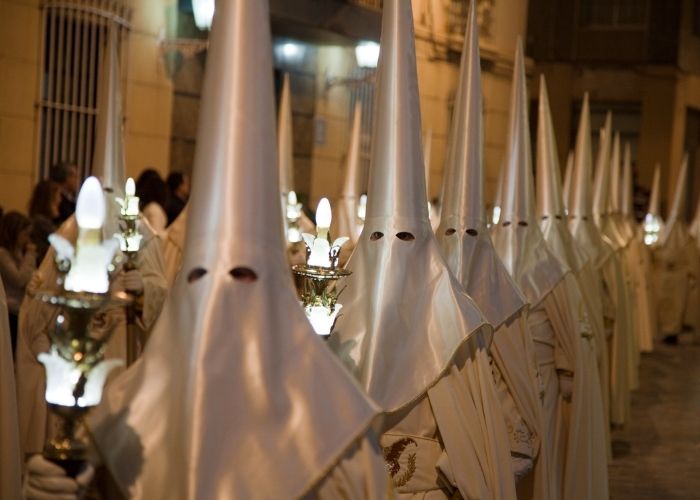
Semana Santa, (Holy Week) celebrates Easter and is from Sunday, April 2 – 9. Almost every village or town in Spain has its own Easter processions. It is one of the most important celebrations in the country. During this week, thousands of people take part in processions to bring massive floats to the church. These floats are huge, intricate, and elaborate pieces of artwork. Each procession begins with an image from the agony of Christ and ends with an image of the Virgin. Some participants ointhe processions can look quite sinister and intimidating as they wear mainly white or purple silky costumes with pointed hoods, covering their heads and faces.
Following the floats are the mourners of the death of Jesus. They are mainly dressed in black and wearing veils. Furthermore, the processions take hours but are not to be missed. At home Spaniards serve traditional Easter food, like ‘torrijas’, ‘buñuelos’, ‘roscos fritos’ and ‘bartolillos’.
Passion in Chinchón – April 23
In its 60th year, La Pasión de Chinchón takes place on Holy Saturday from dusk. On this day, the town is turned into Jerusalem in a living representation of the Passion of Christ. The event begins on the balcony of the Town Hall, where the last supper is re-enacted. The death sentence is given to Jesus Christ, and you can witness his encounter with his mother, the Virgin Mary, Jesus being crucified, and his later Resurrection. Christ’s Ascension is represented in La Asunción Church, surrounded by white smoke and doves. This is an event, where you would fully “live” the experience.
Diada de Sant Jordi – April 23
This romantic day takes place on April 23. It is a day filled with roses, books, and lovers. Throughout Catalonia, World Book Day becomes an especially romantic festivity. It is also the day they celebrate their patron saint, Sant Jordi. The day is like Valentine´s day as we know it, but it is tradition for the men to be given a book and the women to be given a rose. It is an amazing sight, and you will see lots of pop-up books and flower stalls. Romance can be felt everywhere.
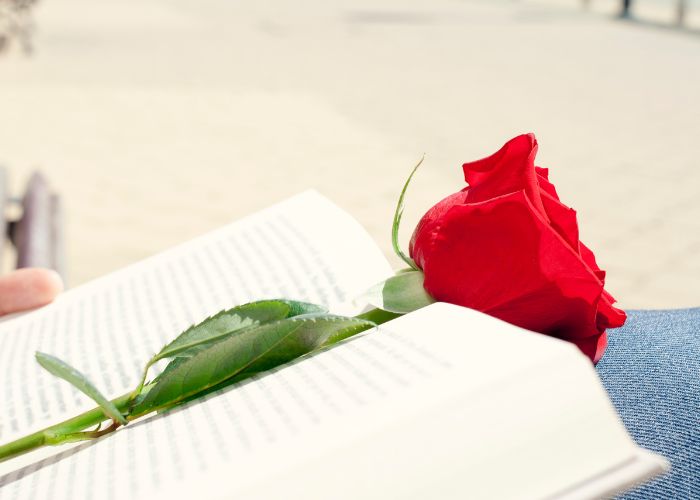
According to tradition, Sant Jordi (Saint George) killed the dragon that used to live in Montblanc where it terrorised the local public, thus saving the king’s daughter from certain death. Legend has it that a beautiful rose bush sprang up in the spot where the dragon’s blood was spilled. From the 18th century onward, the Sant Jordi festival became widely identified as a Catalan ‘fiesta’.
Feria de Abril in Sevilla – April 23 –29

The 2023 Seville Fair begins on Sunday, April 23 and ends on Saturday, April 29 at midnight with a fireworks display. Probably one of the biggest and most important Fairs in Spain is the Seville April Fair. The festival is usually held two weeks following Easter week (Semana Santa); therefore, the actual festival dates vary each year. So, it is always best to check before booking your holiday. The “fish dinner” before the opening of the Fair is on Saturday, April 22. Although the feria is in Sevilla, people come from all over Andalucia. Stunning Flamenco dresses are worn, and the men on horseback wear the traditional “traje de corto”. There are horses and carriages everywhere. The atmosphere is like nothing else you will have experienced.
Battle of the flowers – April 30

The ‘Batalla de las Flores‘ takes place on the last Sunday of April in Cordoba. This is a very colourful sight and is to welcome the start of spring. Floats covered in flowers parade with those on-board throwing carnations to the watching crowds. The crowds then throw the flowers back – thus the name. Some 140,000 carnations are involved. After the battles are over, this event makes way for the Festival de Los Patios Cordobeses at the beginning of May.
MAY
Festival de Los Patios Cordobeses – May 2-14
The locals of Cordoba open their colourful courtyards and patios to visitors from May 3 – 15. The patios and courtyards can be found all around the city. Although the main areas to visit are the Alcázar Viejo district, between the Alcázar and the parish of San Basilio. They can also be seen in the Santa Maria districts close to the Church of San Lorenzo. La Magdalena, the Mosque-Cathedral, and the old Jewish quarter. One of the most beautiful courtyards of all is to be found in the Palace of Viana. Since 1921, the town hall has organised competitions for the best courtyards.
Cruces de Mayo fiestas – May 3
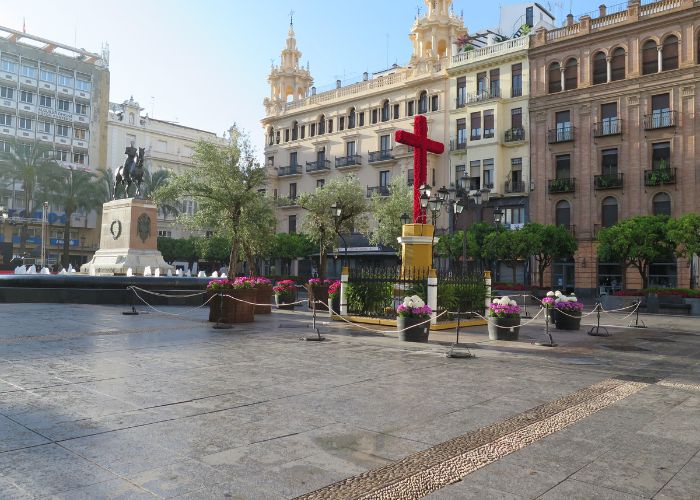
Cruces de Mayo or the festival of the Crosses is celebrated on May 3 in many parts of Spain but has special relevance in Andalucia. It is an event which shows special respect for the cross upon which Jesus was crucified. As legend has it, St Constantine’s mother, St Helen, is the founder of this festival. As the story goes, in the fourth century AD, St Helen’s son Constantine dreamed of a cross that would help him win a battle he was losing. Therefore, he ordered his troops to build him a large cross. They then carried it into battle and subsequently conquered their enemy.
This inspired the family to convert to Christianity and for St Helen to travel to Jerusalem in search of Jesus’ cross. When in Jerusalem she found three crosses. But to confirm which one was authentic, she carried out tests to see which could perform miracles. Only one of the crosses worked. Furthermore, it helped to heal the sick and even brought the dead back to life.
The festivity has been established for centuries (despite a lull in the 70s, 80s, and 90s), and is celebrated by villages, who make crosses and decorate them with flowers or embroidered shawls, and place them at streets and squares. This can also be seen as part of Los Patios.
Madrid Day – May 2
The 2nd of May is one of the most celebrated days in Madrid. The Dos de Mayo is in remembrance of the May uprising, and of the city’s victory over Napoleon in 1808. It is a public holiday for the autonomous community of Madrid where you can enjoy the celebrations, street parties, parades and musical events.
San Isidro – May 13-15
Each year, Madrid celebrates their patron saint, San Isidro. This year, however, is even more special. Pope Francis declared the 12 months from May 15, 2022, to May 15, 2023, the Holy Year of San Isidro. Even more reason for Madrileños and visitors to the city to celebrate. A full programme of events is planned.
Jerez Horse feria – May 6-13
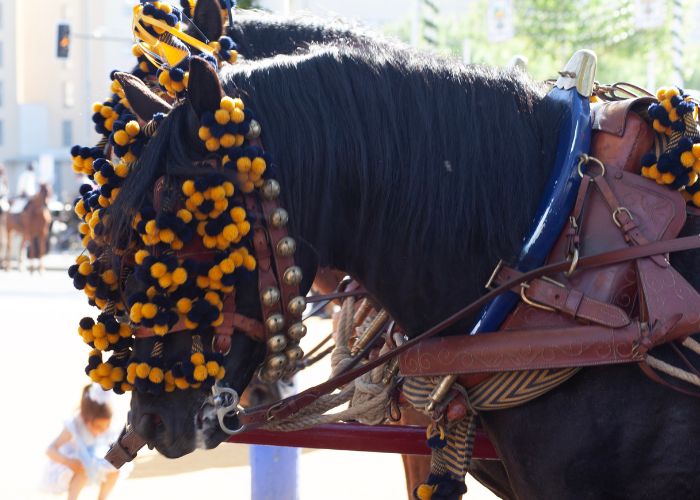
The ‘Feria de Caballo in Jerez dates back some 500 years and is an amazing spectacle whether you are a horse lover or not. The original fairs were organised by gypsies that would come to Jerez to make money by entertaining with their performing horses. However, it was in 1955 when the Domecq Sherry family initiated the idea of a festival as a celebration to recognise the importance of the horse in the city. If you visit, you will see some stunning examples. The event includes parades, street parties, all-night singing, and dancing. Nowadays, thousands of people from all over the world attend.
El Rocío pilgrimage – May 28-29

The famous Romeria del Rocio is held 50 days after Easter during the weekend of Pentecost (May 28 this year). But the pilgrimage begins in the weeks before. Depending on where brotherhoods have to travel to El Rocío (Huelva). The pilgrimage to the village of Rocio is very traditional, and quite a spectacular event. It is one of the largest religious festivals in Andalucia. Hundreds of brotherhoods from surrounding villages and from all over Andalucia and other places in Spain and even Europe take part.
Brightly decorated horse and carts take the pilgrims on their journey. The pilgrims dress in traditional gyspy style flamenco dresses and the men in their “traje de corto” (short jackets and wide-brimmed bolero hats). The goal of every pilgrim is to touch the Virgin Mary who is paraded through the village and around the huge sandy square for over 12 hours.
Romería de Nuestra Señora de la Cabeza
Another famous pilgrimage in Andalucia is the procession to the Sanctuary of the Virgin de la Cabeza. This holy place is located in a unique spot on the highest mountaintop of Sierra Morena. People come here on the third day of the fiestas, after having congregated in Andújar the previous day, thousands of pilgrims visit the region. Most of them are in tare typical Andalucian clothes and riding horses. During the night they sing and dance in front of the Sanctuary. On the last day of the fiestas, the procession of the image of the Virgin takes place.
JUNE
La Patum – June 7-11
La Patum is a festival whose roots are to be found in the theatrical performances of the Middle Ages. Agglutinating, reinterpreting and reportraying centuries-old celebrations, it is held each year in the town of Berga during the week of Corpus Christi. As such, the birth of the festival probably goes back to the second half of the 14th century, although the first written reference to the Corpus celebrations in Berga dates from 1454.
The processions were intended to educate, moralise and teach people so they would have a deeper understanding of the Holy Scriptures. However, nowadays, the Festival and includes a whole series of theatrical performances, characters and figures that fill the city of Berga. Furthermore, the festivities have been proclaimed A Masterpiece of the Oral and Intangible Heritage of Humanity by UNESCO
Pride Sitges

Sitges in Catalonia is home to this massive gay pride event. This year, it will take place from June 14th – 18th. It is one of the most flamboyant in Spain featuring an enormous feast of local food and, of course, lots of wild parties, night shows and tribute acts. Also, there is a fantastic drag queen parade that works its way through the town. The parades take place on the final day. Gay Pride Sitges is listed as one of the 5 best Pride events in the world according to CNN and Lonely Planet reports.
San Juan – June 23

The Festival Noche de San Juan is one of the best June festivals in Spain, especially if you love beach parties. The celebrations begin at sunset on June 23. It is the eve of the celebration before the Feast Day of Saint John the Baptist and a few days after the summer solstice. This ancient pagan festival is legendary as people believe on this night; the pagan gods are closer to humans. This night is how we think of New Year’s Eve in as much as it is about new beginnings.
The night is all about fire and water, where everyone gathers to build fires and enjoy the night. According to tradition to be cleansed and purified, at midnight, you must jump over the fire three times and burn a list of things you wish to say goodbye to. Or you can walk back into the sea, jump the waves three times and let go of a list of wishes for the future. The sea will cleanse you and take your wishes. Alternatively, you can just wash your face in the sea. Every area has slightly different traditions and beliefs.
Madrid Pride – June 23-July 2
The Madrid pride festival is the biggest in Europe and one of the largest in the world for the LGBTQ+ community. The event attracts over 2 million people between June 23 and July 2. The dates incorporate International Pride Day which is on June 28. The full event is packed with parties, parades, activities, and all kinds of entertainment. It is designed to celebrate love and diversity and has visitors of all ages, races, genders, and sexual preferences.
La Batalla del Vino – June 29
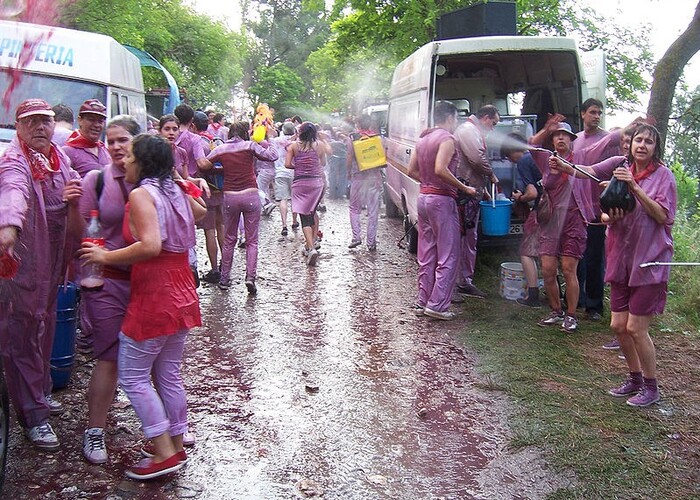
There is an unusual history to this event, the Wine Battle, whereby a dispute by 2 neighbours over the ownership of a cliff was seemingly resolved after throwing bottles of wine at each other. Nowadays, the battle of wine takes place in Haro (La Rioja), the capital of this important wine region in Spain. It is the highlight of the city´s wine festival. The battle begins late the night before, on the Eve of St Peter´s day (28th) and carries on until sunrise the following day. Participants usually wear a white shirt and red scarf. Once the battle is over, everyone has a short nap before drinking the wine.
JULY
Cider festival – July 3-9
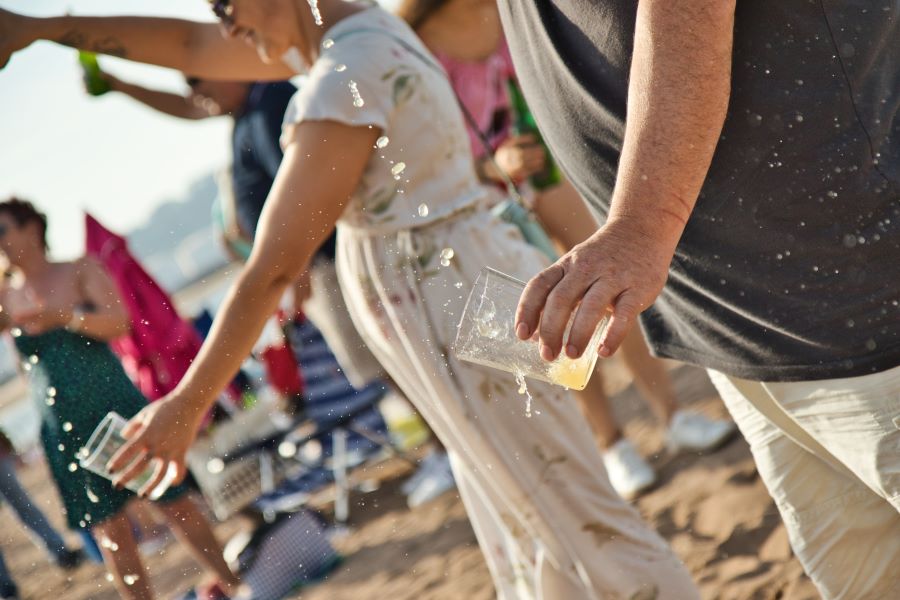
The Cider Festival takes place in the town of Nava in Asturias over the second weekend in July, and the preceding week. Celebrated for the first time in 1969, all sorts of cultural activities connected with the region’s favourite drink take place during the festival. It is a fantastic party atmosphere where you can enjoy folk music, dance, bagpipes (yes, there is a Scottish connection), and live music into wee small hours. This is a perfect place to learn everything there is to know about Cider. There is also a contest to find the best pourers. Also, this is great fun to watch. And if you want to sip some cider for free, tie a green scarf around your neck.
San Fermin Pamplona – July 6-14
Every day during this event, bulls chase a pack of locals and visitors along the streets of the city leading up to the Pamplona bull ring. The Pamplona running with the bulls festival now ranks among the best-known festivals in Spain. Furthermore, it is attended by visitors from all over the world.
This year´s event is from July 6 – 14. If you are very brave, you can run with the bulls, or if not quite so brave, you can always view from the sides of the narrow streets. For those that prefer total safety, some residents rent out their their balconies to give you a good view from above. During the event, there is a full programme of activities aside from the daily bull runs.
Fiestas de Santiago de Apostol Santiago de Compostela – July 15–31
The origin of this fiesta dates back to the founding of the city, when the mortal rmains of the Apostle Santiago were found. According to legend, Pastor Pelayo saw reflections of stars in the forest of Libredón, which gave the city its name “Campus Stellae” (Field of the Star). Thus the combination both gave the current name Santiago de Compostela.
There are activities and music over the 2the 2 weeks especially busy days are 24th and 25th when the whole city turns into a festival. The final day ends in a spectawithlar fireworks display.
Virgin del Carmen – July 16
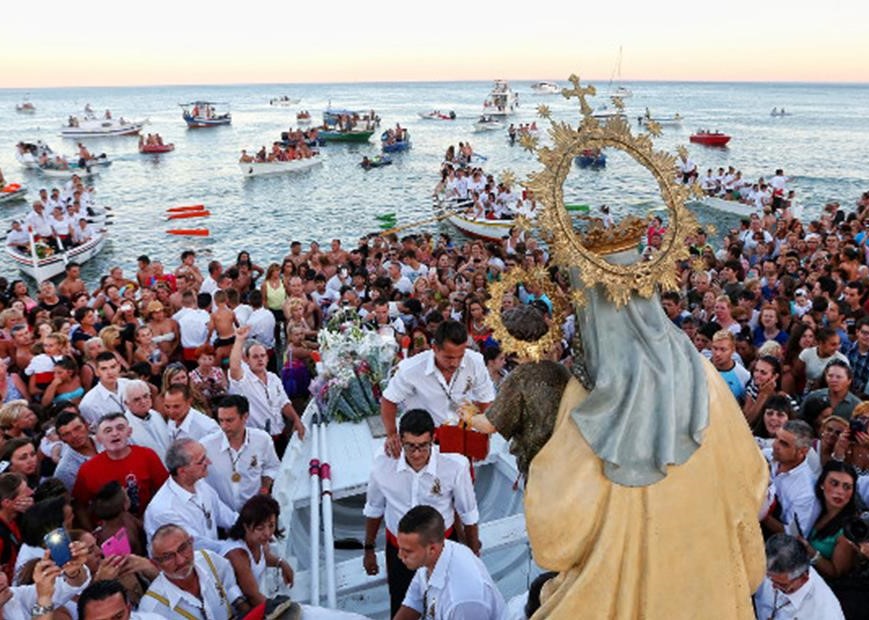
This event takes place in the coastal towns of Spain on July 16. Virgen del Carmen is known as ‘Estrella del Mar’, (the star of the sea). She is of particular importance to Catholic mariners who prayed for her protection. La Virgen del Carmen is the patron saint of fishermen and sailors. It is a day for the virgin to bless sailors and fishermen and to honour those who have lost their lives at sea.
According to legends, the Virgin del Carmen is responsible for keeping the waters around the shore clean and safe. As such, many devotees refuse to swim until after July 16th!
Most of the Día de la Virgen del Carmen traditions involve a parade through the town, en route to the seafront. Usually, a flower-strewn effigy of the Virgin is carried through the streets by a group of local fishermen. When they reach the sea, they are usually met by a flotilla of illuminated and decorated boats, all sounding their horns. After prayers are made for all those at sea, the statue is then taken on a boat. It sails around the local harbour as the fireworks and bands accompany her journey.
AUGUST
Sanlúcar de Barrameda horse races
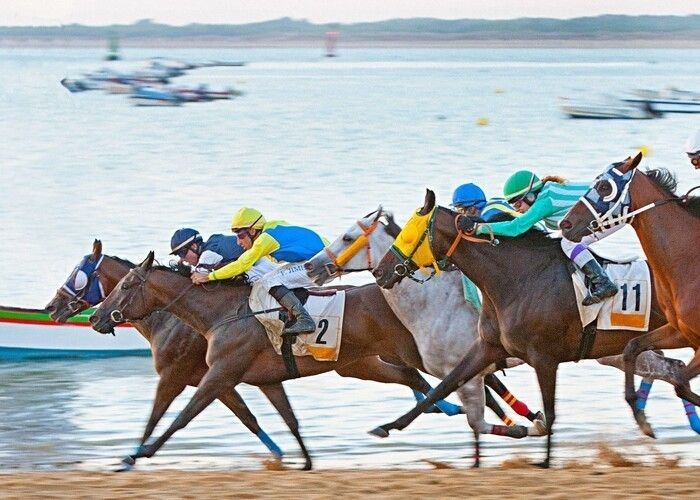
The oldest ‘carrCarrerascabaCaballosSpain take place on the beaches of Sanlúcar de Barrameda (Cádiz) during the st. They are also one of the most unique sporting events in the world. The event is held during the evenings where you can witwhensome of the most spectacular sunsets. Races are divided over two weekends. The first part of the races take place on August 10, 11 and 12 and the second part on August 25, 26 and 27.
Málaga Feria – August 12-19
The Malaga Fair is one of the largest in Spain and commemorates the reconquest of the city by the Catholic Monarchs in August 1487. The Feria de Málaga features music, shows, dancing, horses, fireworks, bullfights and daily processions through the city centre. However, by night, the feria takes centre stage in the Real del Cortijo de Torres.
Assumption Day – August 15
This festival is not unique to Spain as it is celebrated throughout the world. However, it is held on the 15th of August and is a national holiday in Spain. Several towns will hold colourful processions and firework displays for the Assumption of the Blessed Virgin Mary. Furthermore, it is a feast day.
La Tomatina – August 30
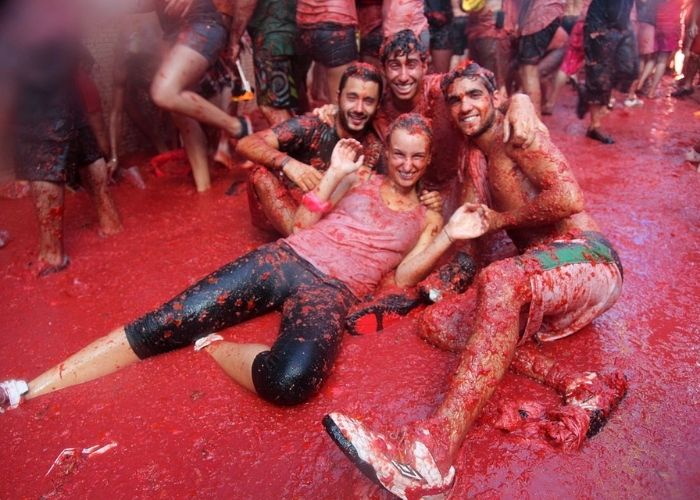
This event has been going since around 1945.on And each year it gets bigger and better. It is celebrated on the last Wednesday of August. Buñol in Valencia is home to La Tomatina the famous tomato festival. Thousands of people make their way to the small village of Buñol to battle it out in the world’s largest food fight. From the moment the cannon fires, the battle begins, and tons of tomatoes are thrown for around half an hour. This is followed by music and dancing; and most likely removing tomato debris. Over a hundred tons of tomatoes are thrown in this unique, fun street battle.
Verbena de la Paloma – August 12-15
Celebrated in the barrio Latina in Madrid, around Plaza de la Paja, in Calle Toledo, in the Plaza de las Visitillas and in tstreets around the parish of the Virgen de la Paloma. The Verbena de la Paloma gives a wonderful opportunity to see people in the itional Spanish flamenco costumes. In addition, there are tapas routes to follow, musical performances, and various activities such as the parade of the Virgin. The wonderful atmosphere in the Spanish capital continues all night in the bars, and restaurants. Moreover, the streets are adorned with lights and garlands.
Mystery of Elche – August 11-15
The Misteri d’Elx is a thaeatrical drama which is sung throughout. It has been designated by UNESCO as Orathe l and Intangible Heritage of Humanity. Entrance is free to see this musical drama of medieval origins. The play is based on several texts from the Apocryphal Gospels. Furthermore, the text is written in the Valencian language, apart from a psalm and a few verses in Latin. The musical part offers the most noteworthy characteristics. The melodies come from different periods and have been added to by different composers. It is a very special event!
SEPTEMBER
Cascamorras in Guadix and Baza – September 6-9
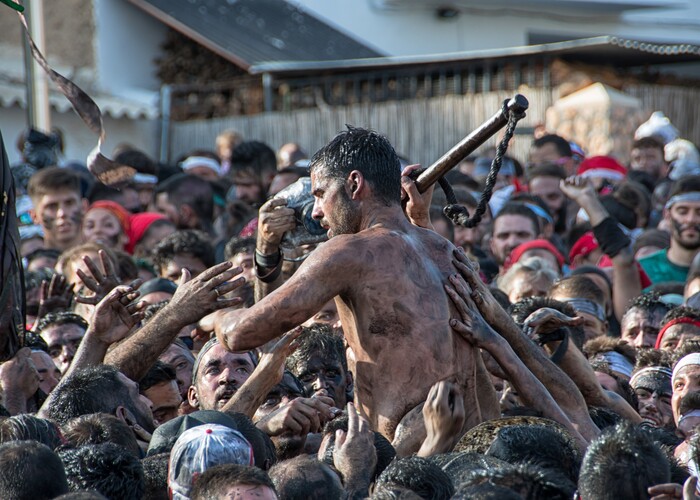
The neighbouring towns of Guadix and Baza are in the province of Granada, Andalucia. This special festival takes place between these towns and dates back to the middle ages when a worker who lived in Guadix discovered a statue of the Virgen de la Piedad (Our Lady of Mercy) while he was working in Baza. He attempted to take the statue back home with him to Guadix. But the villagers stopped him before he was able to leave Baza. He was punished for this as it was considered a sacred theft. When he returned to his own age empty handed, the villagers there were angry and took out their rathwraththe villagers of Baza. Thus they became enemies.
Nowadays, the tale is reenre-enactedch year, someone from the village of Guadix is chosen and attempts to steal the statue from Baza. He is followed by hundreds upon hundreds of people enroen router the 46km distance. At the same time, the residents of Baza try to stop him and the following crowds by throwing paint, and burnt oil as they chase him through the town. EveNowd then villagers pour water from their balconies as the crowds run through the narrow lanes. Finally, on the 9th, they give up and returns to the village in Guadix. When they arrive without the statue, the villagers are also unhappy, and more paint and oil is tareown.
Catalunya national day – September 11
The day-long festival Día de Catalunya commemorates the fall of Barcelona during the War of the Spanish Succession in 1714 and the subsequent loss of Catalan institutions and laws. There are processions and demonstrations throughout the towns and villages in Catalunya on this day.
San Sebastian film festival
2023 marks the 71st edition of the Festival de San Sebastián. Many actors owe their success in the film industry to this famous film festival which was established in 1953. The San Sebastian film festival is by its own right one of the most important film cinematic celebrations of the year. The date has yet to be confirmed but is expected to take place mid mid-Septembernce its inception, some of the most iconic actors have graced the festival. These include Sigourney Weaver, Antonia Banderas, Dame Judi Dench, Penelope Cruz, Ewan McGregor, Johnny Depp and many more.
America Day in Asturias – September 19
The Asturias America Day parade takes place as part of the San Mateo fiestas in Oviedo. The event is a tribute to Asturian emigrants who moved to the US, but came back to visit during the summer months. The festivities begin with the traditional parade of “haigas”. This is the old name for the huge American cars that emigrants brought back with them. There is a colourful parade, with lots of music and dance.
Rioja wine festival – September 21
Logroño is the capital of the world-renowned wine region of La Rioja in northern Spain. And each year they celebrate the grape harvest. The Rioja wine festival is held over a few days around September 21 and celebrates the feast of San Mateo of Logroño. The Festival originated in the 12th century and over time grew in popularity by attracting merchants from all over Spain.
On this day, the grapes are carried by hundreds of children from local vineyards and poured into wine barrels. Then they are transferred into large wooden tubs and pressed by bare-foot men wearing traditional clothing. The first jug filled is offered to the statue of the Virgin de la Valvanera (the patron of La Rioja). As you would expect, the festival involves lots of food, drink, dancing and singing.
La Mercé Festival Barcelona – September 22-25
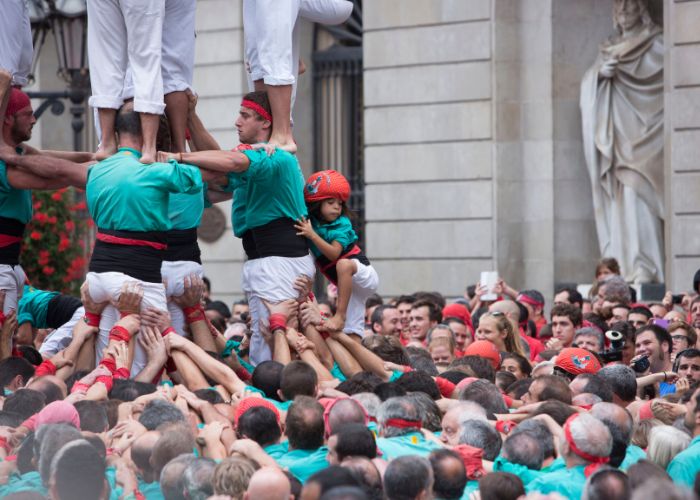
September is the beginning of the closing parties, and La Mthe erce festival is one of the most famous.The event is a farewell to summer and a welcwelcomeautumn. It is a street festival in Barcelona that takes place at the end of the summer season in September and includes numerous live concerts, parades, firewoand rks. It is also famous for the human towers (Castellers). Dating back to 1871, the event is held in honour of Mare de Deu de la Merce (patron saint of Barcelona). Thousands of people gather to watch the Castellers (human towers) take place at the Placa de Jaume.
OCTOBER
Valencia Day – October 9
This is a public holiday for Valencia. It commemorates the date in 1238 when King James I officially entered the city of Valencia, freeing it from Moorish rule.
National Day of Spain – October 12
This is Spain’s national holiday and is celebrated on October 12 each year. During this ‘Día de la Hispanidad‘, Spaniards commemorate the first time that Christopher Columbus sailed from the Canary Islands and spotted the land of the Americas in 1492.
An armed forces parade is held in Madrid, and usually includes members of the Spanish royal family plus a wide range of foreign dignitaries are also usually in attendance.
Guernica Market (900 stalls) – October 30
This is no ordinary market! Guernica hosts the biggest agricultural event of the year on the last Monday of October. Moreover, it is also one of the largest in the entire Basque Country. It is a traditional Basque market, but it takes up the entire centre of the town. The atmosphere is amazing and the quality of the produce is second to none. During the market, there are various exhibitions of different products, and there is a competition of cheeses. The winning cheese is then auctioned for charity. There is every kind of produce you can imagine available for sale. Also, you can see local crafts being made. This is not to be missed.
Halloween – October 31
Halloweén, or All Saints Eve, or “noche de brujas”. In Spain, this evening is celebrated in much the same way as it is in the UK. You dress up as a ghoulish character and party the night away. However, here, it is very much connected with the following 2 days. The first day in November is All Saints Day, and November 2 is the Day of the Dead.
NOVEMBER
All Saints Day – November 1

November 1 is an important national holiday in Spain. Moreover, it is a day for people to reflect on life and remember family and friends who have passed on.
In the morning, there are masses at local cemeteries and churches. But after the remembrance part has finished, it is a day to celebrate the dead.
On November 2, ‘Día de Muertos or Día de Difuntos’, or All Souls’ Day, is celebrated. However, this is more known in other Spanish-speaking countries, such as Mexico, than in Spain itself. Unlike All Saints’ Day, All Souls’ Day is not an official holiday in Spain.
International Sherry Week

Now, in its 10th year, the Jerez de la Frontera Wine Festival is an excellent excuse to get to know everything about Sherry. During International Sherry Week there are plenty of opportunities for wine tasting sessions and pairing events. There are also visits to vineyards for the day and learning how Sherry is made. Also, there are masterclasses and cooking experiences.
This is a real experience for the enthusiasts, and a fantastic introduction to the novice. The date has yet to be confirmed, but it usually takes place in the second week of November.
DECEMBER
Dia de la Constitucion – December 6
This Spanish holiday is celebrated on December 6th and marks the approval of the Spanish Constitution by the Spanish people in 1978. It follows the death of the dictator Franco in 1975 and therefore, the transition to democracy.
Also read: New law punishing glorification from the Franco period
Dia de la Immaculada Concepción – December 8
December 8 is the day of Immaculate Conception of Mary (La Inmaculada Concepción de la Virgen María). Often, the day between December 6 and 8 is taken as a holiday (puente). Furthermore, for those who live in the campo (countryside), it is traditional in these villages for the Matanza. This is the slaughtering of a pig.
El Canto de la Sibila in Mallorca – December 24
Midnight Mass on the 24th, in all the churches in Mallorca, an acoustic performance is given. This is accompanied by at least 2 alter boys, and an organ is usually played alongside. It is a magical experience.
St Stephen´s Day – December 26
Known as boxing day in the UK, St Stephen´s Day is normally celebrated as a family day in Spain. Therefore, on this day, everyone gets together and enjoys the food and atmosphere.
New Year´s Eve – December 31

The year is rounded off in Spain with….yes, you have guessed it – a big party!
New Year´s Eve in Spain is a big celebration. There are many organised events and street parties around village squares. Above all, the most important thing to remember, is to have your glass of cava, and 12 grapes at the ready in time for the clock to strike midnight.


